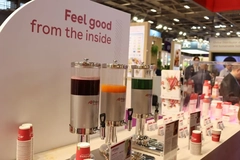HFCS Not Different to Sucrose in Obesity Blame – Study

The study was aimed to address whether energy-containing drinks, especially those sweetened with high-fructose corn syrup (HFCS), promote positive energy balance and thereby play a role in the development of obesity.
14/12/07 The energy balance consequences of high fructose corn syrup (HFCS)-sweetened soft drinks are not different from those of other isoenergetic drinks, e.g., a sucrose-drink or milk, according to research from the Department of Human Biology, Maastricht University in the Netherlands.
The objective was to examine the satiating effects of HFCS and sucrose in comparison with milk and a diet drink. The study was aimed to address whether energy-containing drinks, especially those sweetened with high-fructose corn syrup (HFCS), promote positive energy balance and thereby play a role in the development of obesity.
The effects of 4800-mL drinks containing no energy or 1.5 MJ from sucrose, HFCS, or milk on satiety were assessed, first in 15 men and 15 women with a mean (±SD) body mass index (BMI; in kg/m2) of 22.1 ± 1.9 according to visual analogue scales (VAS) and blood variables and second in 20 men and 20 women (BMI: 22.4 ± 2.1) according to ingestion of a standardized ad libitum meal (granola cereal + yogurt, 10.1 kJ/g).
Fifty minutes after consumption of the 1.5-MJ preload drinks containing sucrose, HFCS, or milk, 170%-mm VAS changes in satiety were observed. Glucagon-like peptide 1 (GLP-1) (P < 0.001) and ghrelin (P < 0.05) concentrations changed accordingly. Compensatory energy intake did not differ significantly between the 3 preloads and ranged from 30% to 45%. Energy intake compensations were related to satiety (r = 0.35, P < 0.05). No differences were observed between the effects of the sucrose- and HFCS-containing drinks on changes in VAS and on insulin, glucose, GLP-1, and ghrelin concentrations. Changes in appetite VAS ratings were a function of changes in GLP-1, ghrelin, insulin, and glucose concentrations.
The study is published in the Dec. 2007 issue of the American Journal of Clinical Nutrition.












